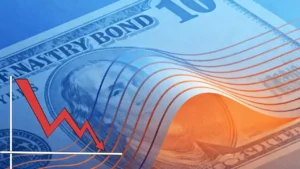Global markets opened the week on a cautious note as renewed U.S.–China trade tensions sent investors rushing toward safer assets. One of the clearest signs of this shift came in the bond market, where the 10-year U.S. Treasury yield briefly slipped below the 4% mark — a level not seen since early September.
The move reflected growing investor anxiety about geopolitical risks, potential supply chain disruptions, and uncertainty surrounding upcoming Federal Reserve policy comments. For many investors, Treasury bonds have once again become the preferred safe haven during volatile times, particularly when trade relations between two of the world’s largest economies appear strained.
10-Year Treasury Yield Falls
As of October 14, 2025, the 10-year Treasury yield dropped to a one-month low of 4.026%, briefly dipping below the psychologically important 4% level before inching back up. This movement signals a renewed appetite for bonds as investors hedge against short-term global risks.
The decline was mirrored across other maturities, with the 2-year yield — closely tied to Federal Reserve rate expectations — falling to 3.487%, and the 30-year yield easing to 4.621%. These shifts suggest that investors are not only worried about trade tensions but also betting that the Federal Reserve could adopt a more cautious approach going forward.
Overview Table: U.S. Treasury Yields as of October 14, 2025
| Treasury Type | Yield (%) | Daily Change (bps) |
|---|---|---|
| 1-Month Treasury | 4.086 | -0.1 |
| 3-Month Treasury | 3.944 | -0.3 |
| 6-Month Treasury | 3.818 | -0.6 |
| 1-Year Treasury | 3.583 | -2.2 |
| 2-Year Treasury | 3.499 | -2.3 |
| 10-Year Treasury | 4.04 | -1.1 |
| 30-Year Treasury | 4.63 | -0.4 |
Trade War Tensions Reignite Market Volatility
The latest downturn in yields follows renewed fears that the U.S. and China may be headed toward another trade conflict. Recent reports suggest that Washington and Beijing have imposed new export restrictions, particularly on critical technologies and rare earth minerals.
This escalation has made investors uneasy, as both economies remain deeply interconnected through trade, manufacturing, and supply chains. Analysts at Eastspring Investments noted that while a complete breakdown in trade is unlikely, both sides appear unwilling to compromise quickly — prompting investors to shift toward lower-risk assets like Treasuries.
Interestingly, sentiment improved slightly after reports emerged that U.S. officials are exploring fresh dialogue with their Chinese counterparts during the IMF and World Bank meetings in Washington. If those talks progress, markets could regain some stability in the short term.
The Federal Reserve’s Role in Shaping Yields
Beyond geopolitical tensions, traders were also watching closely for remarks from Federal Reserve Chair Jerome Powell, who was scheduled to speak at the National Association for Business Economics conference in Philadelphia.
Market participants hoped Powell would offer insights into how the Fed plans to navigate persistent inflation and slowing global growth. A more dovish tone — suggesting fewer rate hikes or potential cuts — could reinforce the downward momentum in yields. Conversely, any hawkish remarks emphasizing inflation risks could reverse the current bond rally.
According to José Torres, a senior economist at Interactive Brokers, “Bond investors are reading between the lines. If Powell hints at policy patience, yields could stay under pressure, as investors lock in long-term rates before the next policy move.”
Why Investors Turn to Treasuries in Times of Uncertainty
When uncertainty looms — whether from wars, elections, or trade disputes — investors often retreat to the relative safety of U.S. government bonds. The U.S. Treasury market, considered one of the most liquid and secure in the world, provides stability and predictable returns when riskier assets like stocks or commodities appear volatile.
The drop in Treasury yields indicates that demand for bonds is outpacing supply, driving prices higher. For context, when yields fall, it’s a sign that investors are piling into bonds, expecting economic turbulence or a slowdown in growth.
This pattern was especially visible in 2025, when both geopolitical uncertainty and mixed economic data created a “risk-off” sentiment across global markets.
Broader Market Context: Global and Political Factors
The yield dip also coincided with global political developments, including a ceasefire deal in Gaza that saw the release of the remaining 20 Israeli hostages. The agreement, brokered with assistance from U.S. President Donald Trump, offered a moment of relief for global investors concerned about instability in the Middle East.
At the same time, signs of progress — however modest — in U.S.–China communication have prevented markets from entering panic mode. While analysts caution that the trade situation remains fluid, the combination of easing tensions in some regions and cautious optimism elsewhere has helped temper volatility.
Still, the underlying message from bond markets remains clear: investors are positioning defensively ahead of a potentially unpredictable end to 2025.
What Lower Treasury Yields Could Mean for Borrowers
For everyday Americans, falling Treasury yields can have real-world benefits. Because mortgage rates and other long-term loans often track the 10-year Treasury yield, a sustained drop could translate into slightly lower borrowing costs.
For example, if the yield holds near or below 4%, mortgage rates could ease toward the mid-6% range, potentially reviving some housing demand after months of slowdown. Corporate borrowers may also see improved financing conditions, while existing bondholders benefit from higher prices on their holdings.
However, there’s a flip side — declining yields can also signal weaker economic growth expectations. If investors are pricing in a slowdown or potential recession, that optimism around cheaper loans may come with broader caution about job markets and spending.
Market Outlook: Watching Powell and Beijing
Looking ahead, much will depend on how Federal Reserve Chair Powell frames his remarks and whether the White House can find common ground with China. Should dialogue between Washington and Beijing lead to a temporary de-escalation, yields might stabilize above 4%.
But if talks break down or inflation data surprises on the upside, the Treasury market could experience another round of volatility. For now, investors appear content to park cash in bonds — a sign that safety, not speculation, is driving sentiment into the year’s final quarter.
10-Year Treasury Yield and Market Reactions
Q1: 1. Why is the 10-year Treasury yield important?
Ans: It’s a key benchmark for everything from mortgage rates to corporate borrowing costs. A lower yield usually signals investor caution and expectations of slower growth.
Q2: 2. What causes Treasury yields to fall?
Ans: When investors buy more Treasuries, prices rise, and yields fall. This typically happens during market uncertainty, trade tensions, or expectations of future rate cuts.
Q3: 3. How do trade wars affect bond markets?
Ans: Trade wars can slow global growth and disrupt supply chains, leading investors to seek safe-haven assets like U.S. Treasuries.
Q4: 4. Will yields stay below 4% for long?
Ans: That depends on Federal Reserve policy and global events. If inflation eases and geopolitical tensions persist, yields could remain lower through late 2025.
Q5: 5. How does the 10-year yield affect mortgage rates?
Ans: Mortgage rates tend to move in the same direction as the 10-year Treasury yield. When yields fall, home loans typically become more affordable.









No Comments Yet
Be the first to share your thoughts.
Leave a Comment